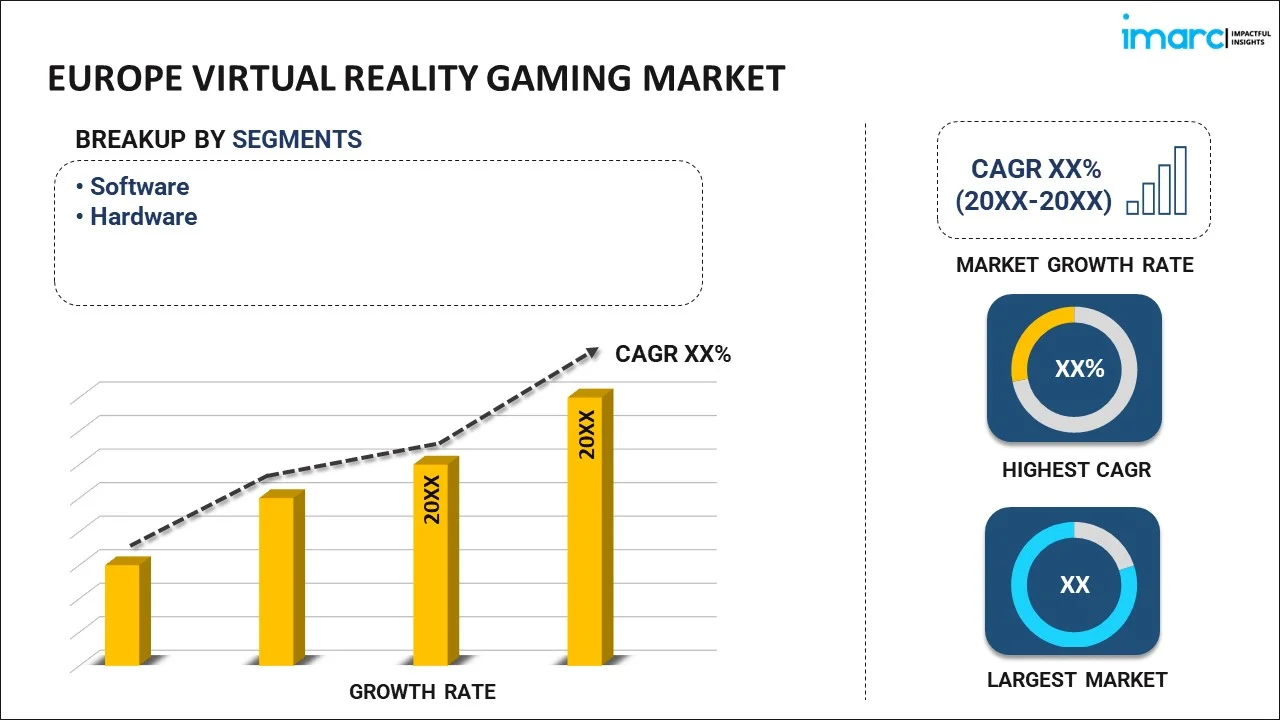
Europe Virtual Reality Gaming Market Report by Segment (Software, Hardware), Device (Personal Computers, Gaming Consoles, Mobile Devices), Age Group (Adults, Children), Types of Games (Racing, Adventure, Fighting, Shooting, Mystery Thriller, Puzzle, Science Fiction, and Others), and Country 2025-2033
Market Overview:
The Europe virtual reality gaming market size reached USD 8.5 Billion in 2024. Looking forward, IMARC Group expects the market to reach USD 30.7 Billion by 2033, exhibiting a growth rate (CAGR) of 14.6% during 2025-2033.
|
Report Attribute
|
Key Statistics
|
|---|---|
|
Base Year
|
2024
|
|
Forecast Years
|
2025-2033
|
|
Historical Years
|
2019-2024
|
|
Market Size in 2024
|
USD 8.5 Billion |
|
Market Forecast in 2033
|
USD 30.7 Billion |
| Market Growth Rate 2025-2033 | 14.6% |
Virtual reality (VR) gaming offers individuals a three-dimensional (3D) environment to experience during a game. It includes 3D images that can be explored interactively on computing devices using a touchscreen mouse and keys. Nowadays, more immersive and sophisticated versions of these games, which involve wraparound displays, VR headsets and VR rooms with wearable computers and other sensory components, are readily available in Europe.
360-degree videos that allow users to watch through every angle, along with an option to rotate and pan as per the requirement, are gaining traction among the young population. This, in confluence with the escalating demand for realistic gaming experiences, represents one of the key factors bolstering the VR gaming market growth in Europe. Apart from this, leading companies are investing in research and development (R&D) activities to launch advanced products and expand their existing consumer base in the region. For instance, VR Electronics Limited, a UK-based company, recently introduced a full-body VR suit and software suite to improve movement, reflexes and instincts of the mind and the body.
Key Market Segmentation:
IMARC Group provides an analysis of the key trends in each sub-segment of the Europe virtual reality gaming market report, along with forecasts at the regional and country level from 2025-2033. Our report has categorized the market based on segment, device, age group and types of games.
Breakup by Segment:

- Software
- Hardware
Breakup by Device:
- Personal Computers
- Gaming Consoles
- Mobile Devices
Breakup by Age Group:
- Adults
- Children
Breakup by Types of Games:
- Racing
- Adventure
- Fighting
- Shooting
- Mystery Thriller
- Puzzle
- Science Fiction
- Others
Breakup by Country:
- Germany
- France
- United Kingdom
- Italy
- Spain
- Others
Competitive Landscape:
The competitive landscape of the industry has also been examined along with the profiles of the key players.
Report Coverage:
| Report Features | Details |
|---|---|
| Base Year of the Analysis | 2024 |
| Historical Period | 2019-2024 |
| Forecast Period | 2025-2033 |
| Units | Billion USD |
| Segment Coverage | Segment, Device, Age Group, Types of Games, Country |
| Countries Covered | Germany, France, United Kingdom, Italy, Spain, Others |
| Customization Scope | 10% Free Customization |
| Post-Sale Analyst Support | 10-12 Weeks |
| Delivery Format | PDF and Excel through Email (We can also provide the editable version of the report in PPT/Word format on special request) |
Key Questions Answered in This Report
The Europe virtual reality gaming market was valued at USD 8.5 Billion in 2024.
We expect the Europe virtual reality gaming market to exhibit a CAGR of 14.6% during 2025-2033.
The increasing popularity of location-based entertainment, along with the rising adoption of advanced laptops and PCs, that provide detailed virtual environments and game options, is primarily driving the Europe virtual reality gaming market.
The sudden outbreak of the COVID-19 pandemic has led to the implementation of stringent lockdown regulations across Europe resulting in the rising demand for virtual reality gaming systems as a means of indoor entertainment.
Based on the segment, the Europe virtual reality gaming market has been segmented into software and hardware. Currently, hardware holds the majority of the total market share.
Based on the device, the Europe virtual reality gaming market can be divided into personal computers, gaming consoles, and mobile devices. Among these, personal computers currently exhibit a clear dominance in the market.
Based on the age group, the Europe virtual reality gaming market has been categorized into adults and children. Currently, adults account for the largest market share.
Based on the types of games, the Europe virtual reality gaming market can be segregated into racing, adventure, fighting, shooting, mystery thriller, puzzle, science fiction, and others. Among these, shooting exhibits a clear dominance in the market.
On a regional level, the market has been classified into Germany, France, United Kingdom, Italy, Spain, and others, where Germany currently dominates the market.
Need more help?
- Speak to our experienced analysts for insights on the current market scenarios.
- Include additional segments and countries to customize the report as per your requirement.
- Gain an unparalleled competitive advantage in your domain by understanding how to utilize the report and positively impacting your operations and revenue.
- For further assistance, please connect with our analysts.
 Inquire Before Buying
Inquire Before Buying
 Speak to an Analyst
Speak to an Analyst
 Request Brochure
Request Brochure
 Request Customization
Request Customization




.webp)




.webp)












